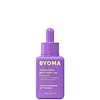What's inside
What's inside
 Key Ingredients
Key Ingredients

 Benefits
Benefits

 Concerns
Concerns

 Ingredients Side-by-side
Ingredients Side-by-side

Water
Skin ConditioningBifida Ferment Lysate
Skin ConditioningPEG-8
HumectantPropanediol
SolventBis-PEG-18 Methyl Ether Dimethyl Silane
EmollientMethyl Gluceth-20
HumectantGlycereth-26
HumectantPEG-75
HumectantButylene Glycol
HumectantAdansonia Digitata Seed Extract
Skin ConditioningTripeptide-32
Skin ConditioningSodium Hyaluronate
HumectantYeast Extract
Skin ConditioningLactobacillus Ferment
Skin ConditioningCola Acuminata Seed Extract
Skin ConditioningAnthemis Nobilis Flower Extract
MaskingHydrolyzed Algin
Pantethine
EmollientCaffeine
Skin ConditioningLecithin
EmollientSodium Rna
Skin ConditioningBisabolol
MaskingSqualane
EmollientGlycerin
HumectantOleth-3 Phosphate
Caprylyl Glycol
EmollientOleth-3
EmulsifyingOleth-5
EmulsifyingCholeth-24
EmulsifyingHydrogenated Lecithin
EmulsifyingJojoba Wax PEG-120 Esters
Ceteth-24
CleansingTocopheryl Acetate
AntioxidantCarbomer
Emulsion StabilisingTriethanolamine
BufferingTetrasodium EDTA
BHT
AntioxidantXanthan Gum
EmulsifyingPotassium Sorbate
PreservativeDisodium EDTA
Phenoxyethanol
PreservativeCI 14700
Cosmetic ColorantCI 19140
Cosmetic ColorantWater, Bifida Ferment Lysate, PEG-8, Propanediol, Bis-PEG-18 Methyl Ether Dimethyl Silane, Methyl Gluceth-20, Glycereth-26, PEG-75, Butylene Glycol, Adansonia Digitata Seed Extract, Tripeptide-32, Sodium Hyaluronate, Yeast Extract, Lactobacillus Ferment, Cola Acuminata Seed Extract, Anthemis Nobilis Flower Extract, Hydrolyzed Algin, Pantethine, Caffeine, Lecithin, Sodium Rna, Bisabolol, Squalane, Glycerin, Oleth-3 Phosphate, Caprylyl Glycol, Oleth-3, Oleth-5, Choleth-24, Hydrogenated Lecithin, Jojoba Wax PEG-120 Esters, Ceteth-24, Tocopheryl Acetate, Carbomer, Triethanolamine, Tetrasodium EDTA, BHT, Xanthan Gum, Potassium Sorbate, Disodium EDTA, Phenoxyethanol, CI 14700, CI 19140
Helianthus Annuus Seed Oil
EmollientMacadamia Ternifolia Seed Oil
EmollientSimmondsia Chinensis Seed Oil
EmollientHippophae Rhamnoides Oil
EmollientDipropylene Glycol
HumectantSqualane
EmollientSphingolipids
EmollientHydroxyacetophenone
AntioxidantOlea Europaea Fruit Oil
MaskingRosa Canina Fruit Oil
EmollientPrunus Amygdalus Dulcis Oil
Skin ConditioningCaprylyl Glycol
EmollientCeramide NP
Skin ConditioningEthylhexylglycerin
Skin ConditioningTocopherol
AntioxidantDipotassium Glycyrrhizate
HumectantTanacetum Annuum Flower Oil
MaskingHelianthus Annuus Seed Oil, Macadamia Ternifolia Seed Oil, Simmondsia Chinensis Seed Oil, Hippophae Rhamnoides Oil, Dipropylene Glycol, Squalane, Sphingolipids, Hydroxyacetophenone, Olea Europaea Fruit Oil, Rosa Canina Fruit Oil, Prunus Amygdalus Dulcis Oil, Caprylyl Glycol, Ceramide NP, Ethylhexylglycerin, Tocopherol, Dipotassium Glycyrrhizate, Tanacetum Annuum Flower Oil
 Reviews
Reviews

Ingredients Explained
These ingredients are found in both products.
Ingredients higher up in an ingredient list are typically present in a larger amount.
Caprylyl Glycol is a humectant and emollient, meaning it attracts and preserves moisture.
It is a common ingredient in many products, especially those designed to hydrate skin. The primary benefits are retaining moisture, skin softening, and promoting a healthy skin barrier.
Though Caprylyl Glycol is an alcohol derived from fatty acids, it is not the kind that can dry out skin.
This ingredient is also used as a preservative to extend the life of products. It has slight antimicrobial properties.
Learn more about Caprylyl GlycolSqualane is an emollient that helps the skin hold onto moisture. It's an oily liquid that occurs naturally in certain types of fish and plant oils.
Because squalane boosts hydration in the skin, it also comes with plenty of benefits: it is an antioxidant and can help fight free radicals and skin damage. Squalane is also found to have a detoxifying effect when applied.
Squalane comes from squalene, which occurs naturally within the sebum of our skin. It is one of the oils our skin produces to keep itself hydrated. Squalane is the hydrogenated version of squalene and has a longer shelf life.
Research shows that squalane is non-irritating (even at 100% concentration).
In general, it's a fantastic ingredient. It does a great job at hydrating the skin, and it's suitable for those with sensitive skin.
The source of squalane may impact malassezia / fungal acne. This is because olive oil derived squalane can contain impurities such as fatty acids and plant waxes. Sugarcane derived squalane is recommended for anyone with malassezia concerns.
Is squalane vegan?
This depends on the source. Squalane can be derived from both plants and animals. Most squalane used in skincare comes from plants.
Please note: the source of squalane is only known if disclosed by the brand. We recommend reaching out to the brand if you have any questions about their squalane.
Read more about squalene with an "e".
Is squalane an oil?
Squalane is often called an oil, but it’s technically not; it’s a hydrocarbon, meaning it’s only made of carbon and hydrogen, unlike true oils which are triglycerides made of fatty acids and glycerol.
The term “oil-free” isn’t regulated, so companies can define it however they want. Some exclude all oils, while others just avoid mineral oil or comedogenic oils.
While some people avoid oils thinking they cause breakouts, the right kind of oil (or oil-like ingredient like squalane) can actually help balance and hydrate your skin. It’s worth testing out simple oils or squalane to see what works best for your skin.
Learn more about Squalane